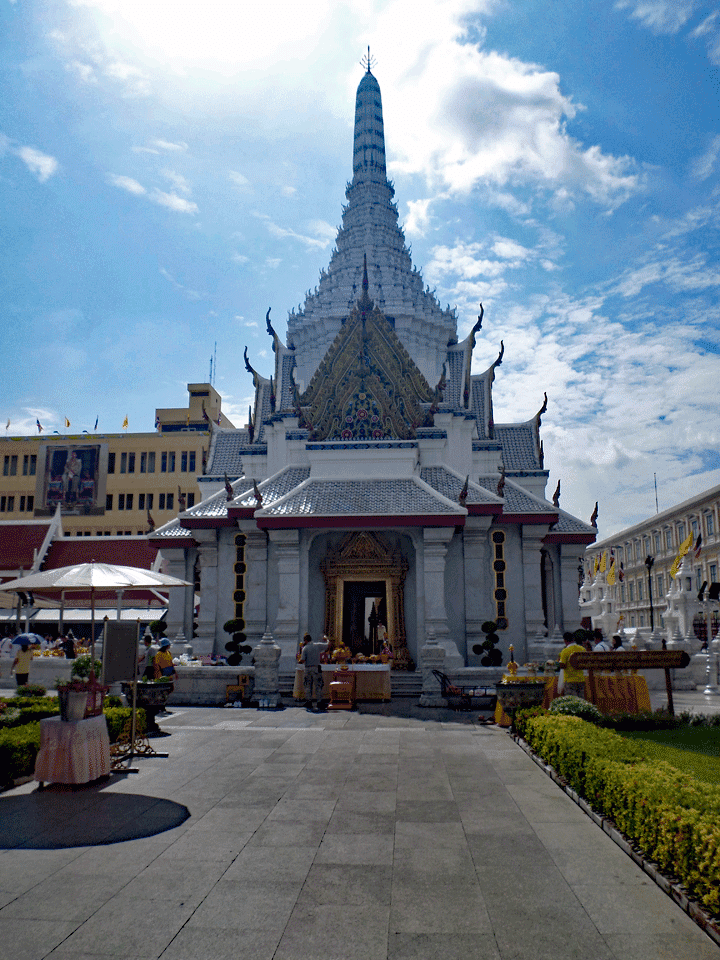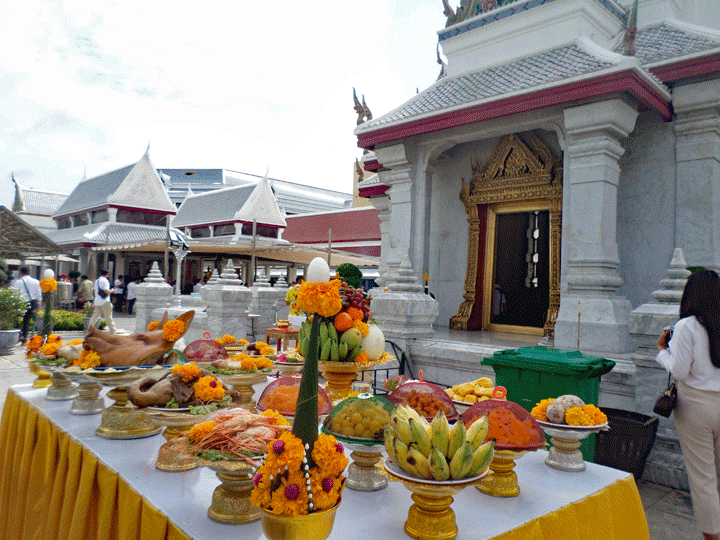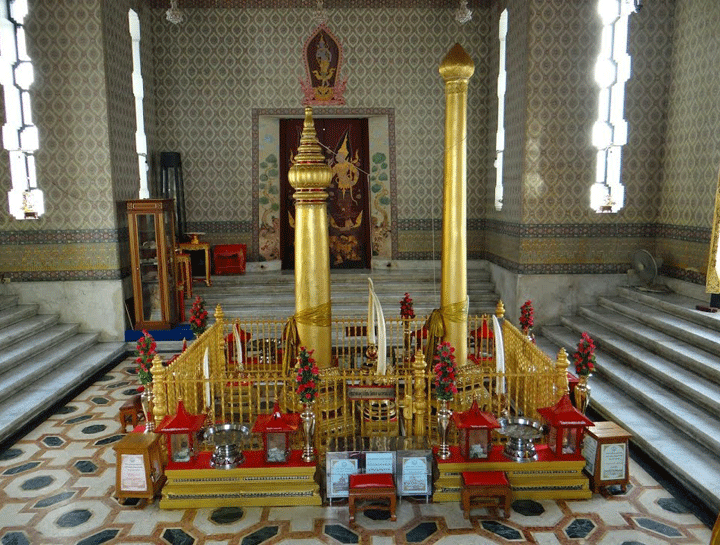The City Pillar of Bangkok

In most of Thailand's major cities one can find one Lak Muang or city pillar. These pillars are believed to house the Chao Pho Lak Muang or the guardian spirit of the city, but in fact these pillars indicate the spiritual center of a city.
In Chiang Rai, the pillar becomes even Sadue Muang or called the navel of the city. Traditionally, according to an ancient Brahmanistic custom, these pillars are made of acia wood. However, teak was used in a few cases. Although old manuscripts sometimes refer to pillars made of brick or sandstone. Very often they were painted gold or painted blood red before the initiation.
Despite the fact that these pillars have been studied regularly and generated a great deal of academic ink, the origin of their use to erect and venerate them remains unclear. City pillars can often be found at or near the geographic center of a city, at the point where the diagonal lines, starting from the corners of the old city walls, intersect.
One of the oldest and perhaps most revered city pillars can be found in it San Lak Muang or Shrine of the City Pillar of Bangkok. I have visited this shrine several times and have noticed how often it is frequented by large groups, usually from the same company. This may have a lot to do with the widespread belief that an offering to this shrine brings prosperity and satisfaction at work and furthermore would promote professional career…

The City Pillar Shrine in Bangkok was the first official structure to be built in the new capital of the Ratanakosin period. In other words, it is older than the palaces. The pillar was dedicated on April 21, 1782, the day Rama I proclaimed Bangkok the capital of the kingdom. The pillar originally stood on the southwest corner of Sanam Luang. A persistent legend tells how on the day the pillar was placed, four serpents were crushed under the pillar. This was seen by many as a bad omen and seers predicted that the city would disappear after 150 years. King Rama IV, who was a renowned astrologer, decided to err on the side of caution when he moved the pillar to the southeast corner of this immense plaza, where it still stands in the shadow of the Palace and Wat Phra Kaew today. This legend may also have something to do with another persistent city story that states that four people were executed at the dedication, each of whom was buried in one of the four cardinal points near the shrine to protect the shrine with their spirits…

The original city pillar from 1782 was 472 cm. high, of which 200 cm was dug in as a base. Both shrine and pillar fell into disrepair over the years and Rama IV, when moved to the new location, had a new one placed next to the original one. Consequently, the shrine has two city pillars instead of one. The new one is 511 cm high, of which 180 cm protrudes above the ground. An altar can be found at the shrine, which has an openwork structure on four sides, and there are also five imposing elephant tusks set up within the fence that encloses the pillars. The structure is topped by a dazzling white-painted spire or Prang said to have been modeled on the Ayutthaya city pillar shrine destroyed by the Burmese.
In 1980, in preparation for the 200e anniversary of the pillar, the site underwent a major renovation. The last restoration, which focused mainly on conservation works, was completed in February 2007.


Human sacrifice, especially pregnant women, was almost certainly a beautiful and authentic Thai tradition that we should respect when building forts and city gates in the Ayutthaya period. That it also happened at the city pillars is probable but not entirely certain.
Jeremias van Vliet, who was in charge of the Dutch East India Company's office in Ayutthaya from 1629 to
1634, describes not only the general custom of impaling pregnant women under the posts which
support fortifications, but also relates in elaborate detail how in 1634 the king's plans to do so with 68 women had to be abandoned, and how only four were actually sacrificed 16. The spirits
of pregnant women who died would make ferociously supernatural agents, a belief that is still
strong today.
http://www.siamese-heritage.org/jsspdf/1971/JSS_066_2g_Terwiel_OriginAndMeaningOfThaiCityPillar.pdf
Great addition, Tino! Your source research is flawless.
1629-1634, isn't that the period when similar unreal women's sacrifices also took place in the Netherlands?
The witch trials with strangulation or sacrifice on the blazing pyre! This included women and girls who were pregnant…
Roughly speaking, these lofty rituals took place in the Netherlands from 1450 to 1720. A bit longer than in Ayutthaya, I think. It was a European tradition.
But still, the Netherlands has baked it brown. Very late, in 1674 a last witch trial took place in Limbricht.
The sacrificial sheep was Entgen Luyten, who was found strangled in her cell after days of torture and before her sentence.
A mysterious case that has never been solved. The men of the aldermen got out of it by declaring that Entgen had committed suicide in the dungeon. Case closed.
And even worse, even in 1823 a water test took place in Deldenerbroek, but witch Hendrika sank as fast as an arrow and thus proved that she was not a witch.
Unbelievable: this continued until 1823! Illuminated homeland.
In Thailand, those abuses took place under an absolute monarch and his arbitrariness. In the Netherlands under the laws of a civil administration and the applicable jurisprudence.
The latter is much worse for me. They were not impulses of the moment but conscious legal processes, with evidence, judges and lawyers. High level democracy.
34 years after the French Revolution (liberty, equality, fraternity).
Once again we see that people are the same everywhere and that cultures do not differ that much from each other, at most in small variations. And we should therefore not feel better (culturally-socially-legally) than the Thai or other citizens of the world.
https://historiek.net/entgen-luyten-heksenvervolgingen/67552/
Speaking of witches, think of the English 'witch'. Shares the same language roots as Thai วิทยา (wié-ta-jáa, knowledge, science) and วิชา (wíe-chaa, knowledge of study). Women with knowledge are extremely dangerous... In those beautiful European traditions, men knew what to do with that. (Throughout the centuries, men have not made life so pleasant and easy for many women, worthless figures, those men..)
Indeed, we humans are essentially the same, the implementation differs slightly, but the motivations behind a use have common denominators.
Ah, Rob, surely the Thai have taken the concept of 'wietajaa' from Pali via India, just as they have adopted more words via Hinduism and Buddhism.
Pali is an Indo-European language > branch Indo-Iranian > branch Indo-Aryan.
So it makes sense that the root of that word can also be found in Germanic or Romance languages. As you posit. Fascinating!
Or how cultures still encounter each other through inscrutable ways.
Wiethajaa, knowledge, science'. Our word 'to know' and the German 'to erase' also has as its root the word 'white' in Sanskrit. After all, we are all Indo-Europeans
Indo Europeans? based on?
Surely you don't believe that yourself.
Hard evidence is not always available to substantiate statements about the Indo-Europeans. Few known archaeological cultures can be unequivocally designated as Indo-European, and there are no written records of the period. Research therefore often retains a hypothetical character.
Actually Indo-European languages….No?
Dear readers of this blog,
Soap Flower
During my last visit to Belgium, friends asked me to bring the famous hand-carved soap flowers with me on my next visit from Thailand.
They had received a set of 3 (small, large, larger) packed in a round box with a round lid from Chiang Mai from their daughter who was on leave there and they loved it.
I live in Udon Thani and after a few searches here they are not to be found, not in the markets, not in Central Plaza, I also did a few shops and even went to Nongkhai market where they have just about everything, usually I get told they only have them in Chiang Mai.
Ordered a few online, but the picture is usually nicer than in reality.
Does anyone happen to know a hidden place or shop in Udon Thani where they have it.
Preferably no maybe answers like maybe in… maybe in…
Thank you in advance.
Indeed, at the Night Market in Chiang Mai you can get them by the kilos. Various designs. And very cheap. Can be seen in few other places in Thailand.
Maybe in MBK if you look closely. You can find original souvenirs there and also many things from the hill tribes from Northern Thailand. Fabrics, dolls, patches, elephants of beautiful Thai fabric and design, etc.
On the floor of the watches there is a small stall where they have very original souvenirs.
I always congratulate the owner on her resourceful choices.
She's really looking for it.
Can be found in many places in Phuket and on Koh Samui. We were there in March
At the time I understood another version of the snakes under the city pillar (Lak Mueang)
Great unrest arose when one day the city pillar was a lot higher. It turned out to house 4 snakes, which were killed